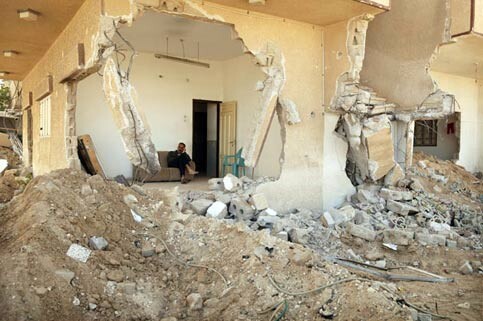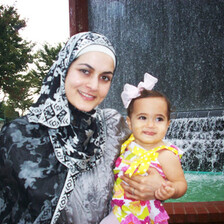Al Jazeera 3 June 2004

The aftermath of “Operation Rainbow” in Brazil refugee camp, Rafah, Gaza. (Johannes Abeling)
Monday 31 May 2004 — Muhammad Juma was still trying to make sense of what had just happened. Incensed as he was, he sat sipping a cup of mint tea next to a caged, limping coyote and a bouncy kangaroo.
Spread out in the field in front of him was an array of rotting carcasses, with the imposing stench that only death imparts. Two gazelles lay facing each other, the look of fear frozen on their faces.
Besides the carcasses, the only indication that a zoo once occupied this empty field was a rusty welcome sign that had fallen to the ground. Everything else had been brutally ploughed over with military tanks and bulldozers.
This was to be the fate of the animals in Gaza’s only zoo - some of the first victims in last week’s now infamous “Operation Rainbow”, which ravaged the Palestinian refugee camp of Rafah in the occupied southern Gaza Strip.
Indiscriminate killing
Animals, of course, were not the only casualities of the Israeli raid, but their death and the Israeli destruction of the Rafah zoo provide a glimpse of the indiscriminate nature in which it was carried out.
At least 1650 Rafah residents were made homeless here within a span of 72 hours. Fifty-five Palestinians, mainly civilians, were killed and at least 200 others injured. Almost all were unarmed.
Such wanton destruction has left many residents of Rafah wondering just how Israeli occupation troops are justifying their largest invasion yet of the refugee camp.
Tunnels, say local residents, cannot be dug more than 80m from the border with Egypt and cannot allow the sophisticated artillery Israel claims is being smuggled in.
The zoo is more than a kilometre away.
“Most of the destruction was in the old part of the Brazil camp which is significantly inland. It’s impossible to build tunnels this far in,” says Abu Hamzah of the Islamic Relief Society, which has distributed several tonnes of foodstuffs and clothes to the victims of Rafah.
Abu Hamzah’s own home in Rafah was demolished earlier last month.
“It was destruction for the sake of destruction,” says Juma. “It took me years to build up this collection of animals - it was my life’s work.”
Destruction revealed
In the Tal al-Sultan neighbourhood of the Rafah camp, nearly two kilometres away from the border, Majid Mishwakhi recounts in unflinching detail the unfolding of events.
During the first 48 hours of Operation Rainbow, more than 11 Palestinians were killed within two neighbourhood blocks, he recalls.
“Four AM. Missile number one lands here, killing Hani Guffa, 18 years old,” says Mishwakhi. “Missile number two: Hani Balawi and son, Tariq Adl, and Muhammad Shair who came to their aid, all killed instantly. I was crouching right over there, a few feet away,” he continues, walking a few metres forward.
“Missiles three and four,” he goes on, pointing to the now burned out exterior of the al-Bilal Mosque in the centre or town. Prior to the invasion, the mosque housed the largest collection of religious texts in the Gaza Strip.
Inside, the once pristine prayer hall and its white Jerusalem brick exterior are blackened from the smoke of the resulting fire.
Shattered glass and the embers of thousands of pages of books blanket the ground, and half-burned copies of the Quran sit on the bookshelves.
“I was at the mosque when the missiles hit,” recounts eyewitness Rami Ghawa. “There were no militants, no arms, and no tunnels. We were just finishing the morning prayers. There was absolutely no reason for them to target this place of worship.”

A mosque hit by missiles from an Israeli combat helicopter in Tel Al-Sultan, Rafah, Gaza. (Johannes Abeling)
Shoot to kill
East of the mosque, down a tiny alley, is the Abu Libdah household.
On 18 May, the second day of the invasion, Sabir Abu Libdah, 13, left his home with a white flag in hand to fetch some water for his family. He had barely made it out of the alley when he was shot three times in the heart by an Israeli sniper positioned in a building across the street.
When his older brother Yusuf, came to his rescue, he too was shot - in his rib, shoulder, and hand. Then came the third brother, Ayub. The sniper shot him twice in his arms.
All three stumbled back into the house, leaving behind a trail of blood. Family members who inspected the wounds say the type of bullet used was one that shatters on impact, leaving behind difficult-to-remove fragments in the bone and skin.
“I’m dying, father, I’m dying”
“[Sabir’s] last words were: ‘I’m dying, father, I’m dying,’” recounts his grief-stricken father, as he points to the blood-stained wall where all three brothers collapsed. “The ambulances were not allowed in for at least two hours. The bullets wouldn’t stop coming, it was like an all-out war.”
The elder brothers are in critical condition in Rafah’s Najjar Hospital.
Next door, Asma and Ahmad al-Mughayir, 16 and 13 years old respectively, were shot dead while standing on the roof of their house. Both received one bullet to the head.
Two blocks away, Muhammad Jabir turned the corner of his house and received six fatal bullets to the chest. Meanwhile, in a building north of the Mosque, Shamal Awad Assar was shot dead on his balcony while transporting a gallon of water from his neighbour.
Battle plan
Across the street from the Abu Libdeh household, west of the mosque, is the building from which the Israeli sniper shot the three brothers.
It is the home of Samir Barud and his family. Soldiers blew out the back door of his home with dynamite after demolishing the house behind it, says Barud.
After searching the area for arms, the soldiers locked the men and women into separate rooms, 35 people in total, and went upstairs to take position.
Barud says Israeli soldiers used him as a human shield, forcing him to go downstairs and inspect the area for armed Palestinians.
“They thought they heard a ruckus so they took me and told me to scope the area out, so if anyone was to get shot first, it would be me,” says Barud. “Lucky for me no one was there.”
“They took our mobile phones, cut the landlines, turned off the electricity, and nested their snipers upstairs,” he continues, as he picks up two sniper shields that the soldiers had left behind in the rubble of his neighbour’s home.
On their back, scribbled in Hebrew with tiny illustrations, is what looked like a battle plan.
“After they left we discovered that they had defecated in the house and placed our Quran in the toilet,” says Barud.
Now, nine days later, in a corner of the refugee camp, a cleaner calmly sweeps the overturned streets, seemingly oblivious to the futility of his task.
Past a broken jar of olives and a dismembered doll are the remains of a bombed-out elementary school.
On it in big bold letters is spray-painted a simple, but telling message: “Sharon was here.”
Related Links
Laila El-Haddad is a correspondent for Al-Jazeera.



